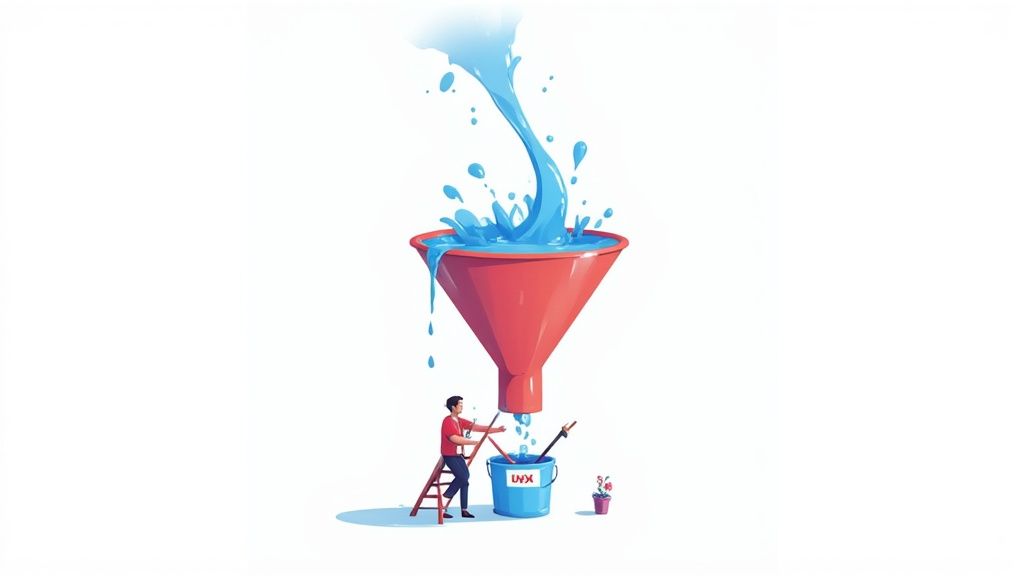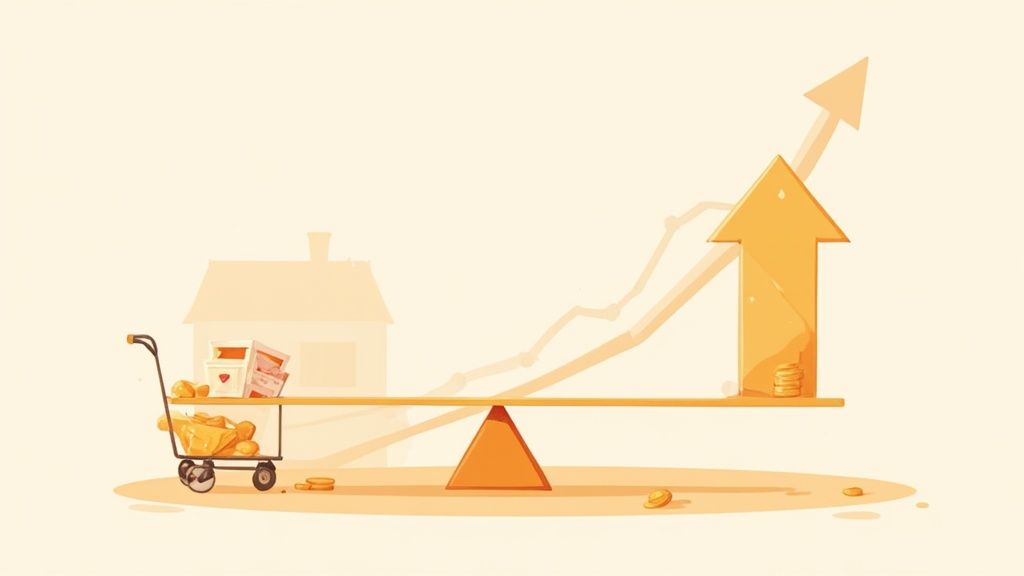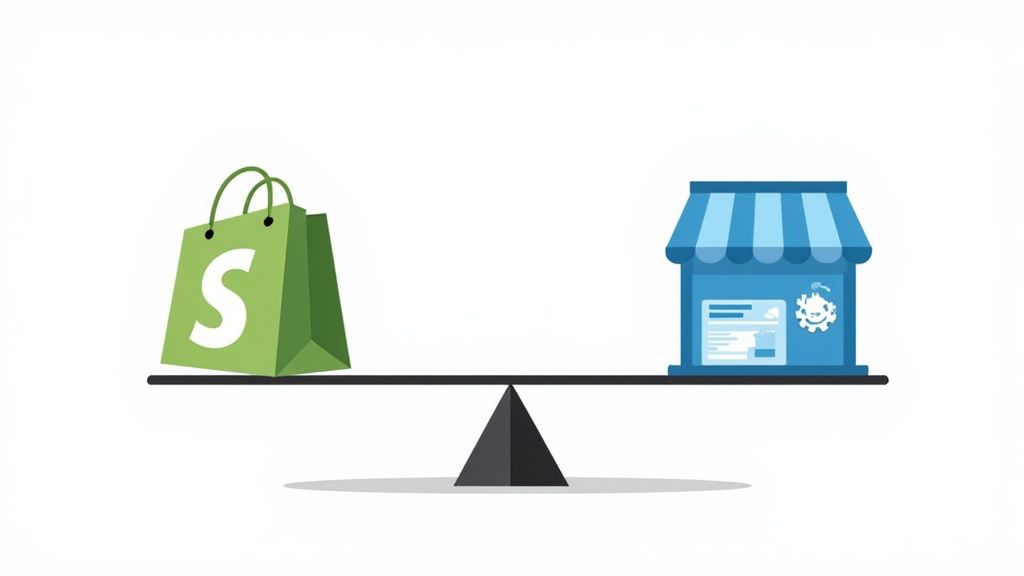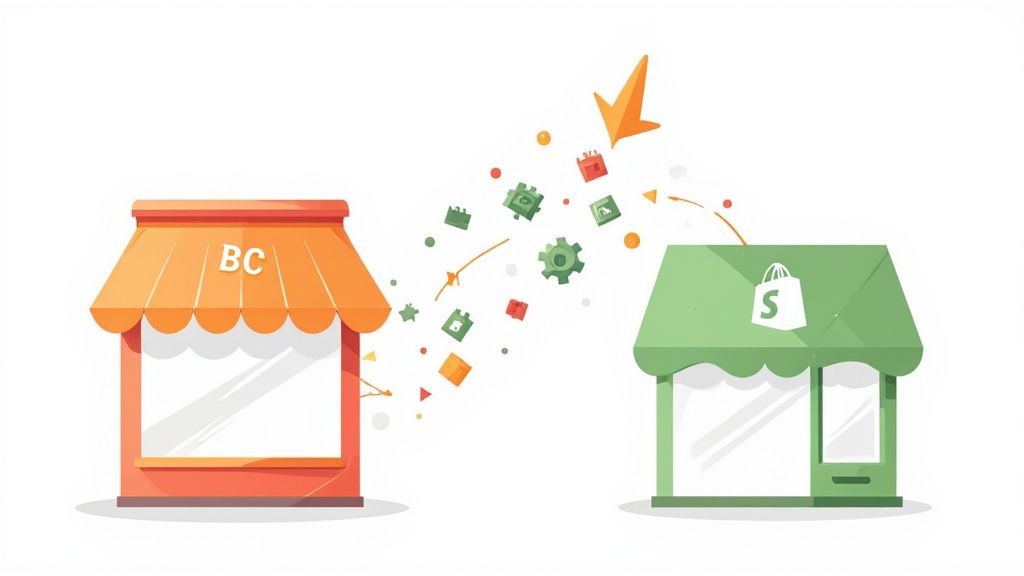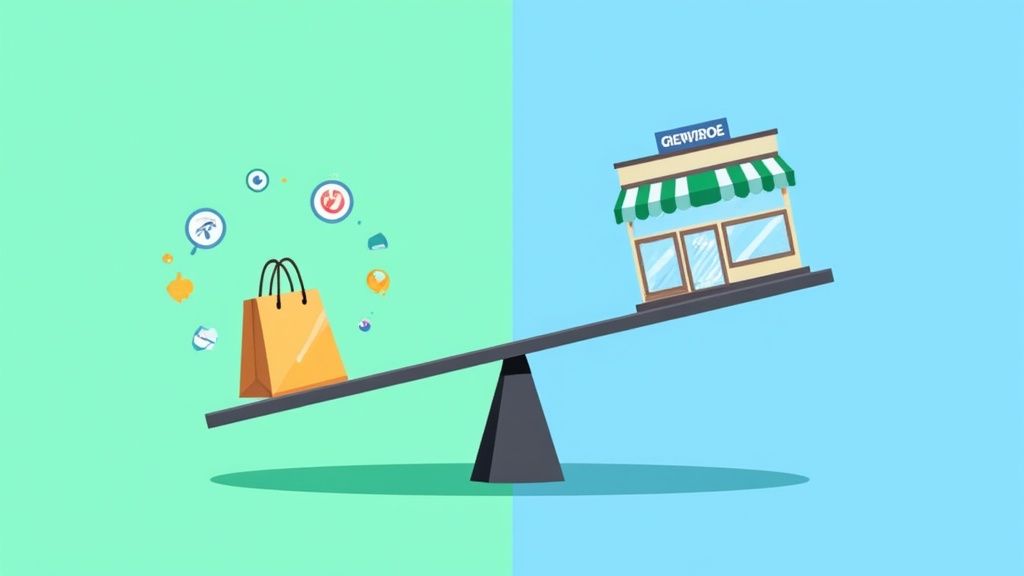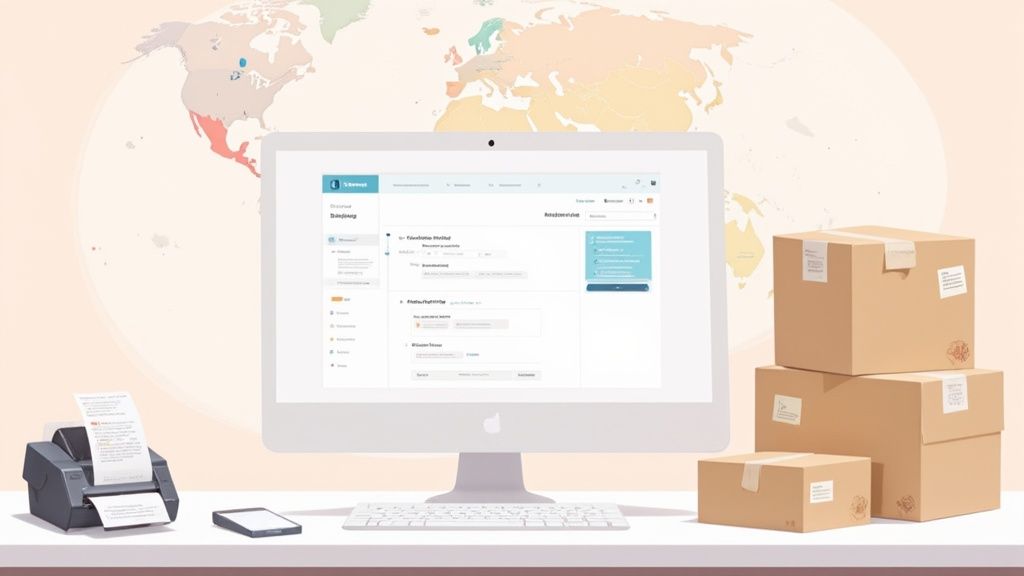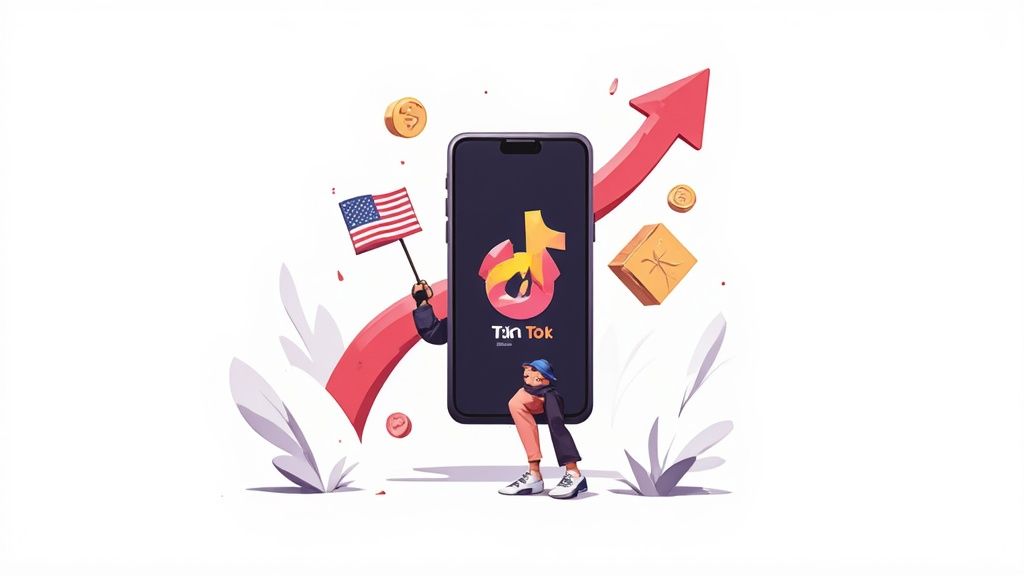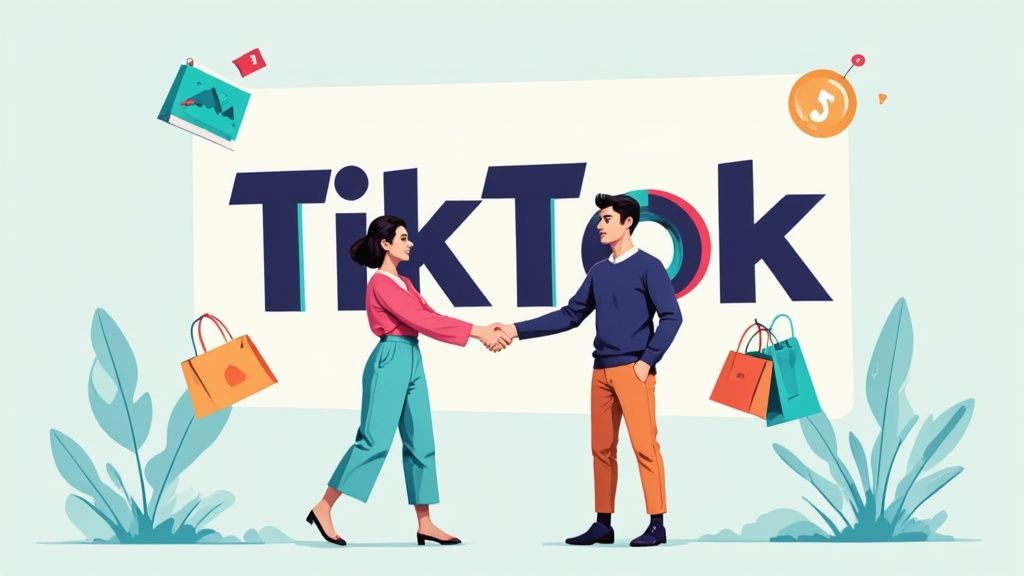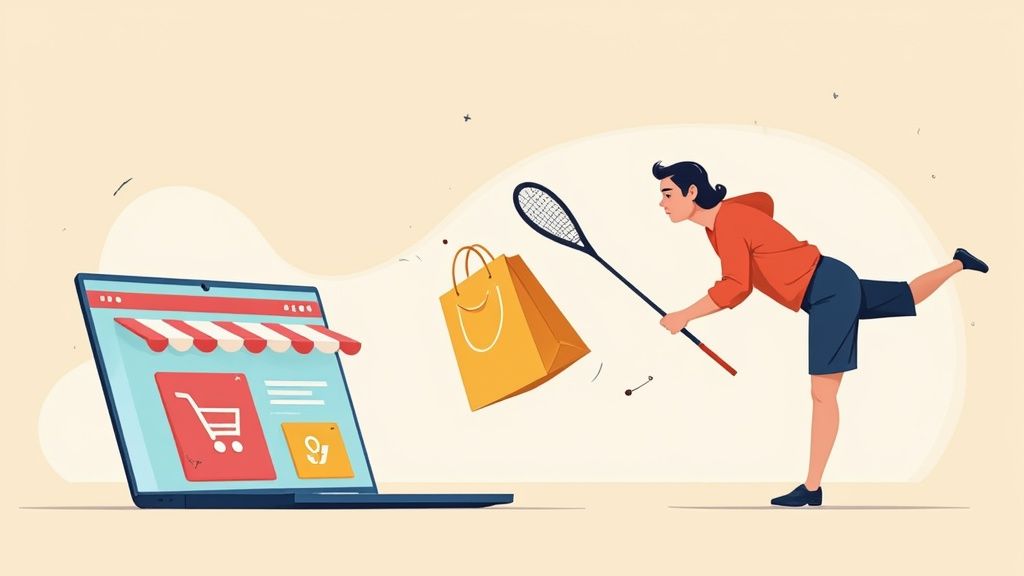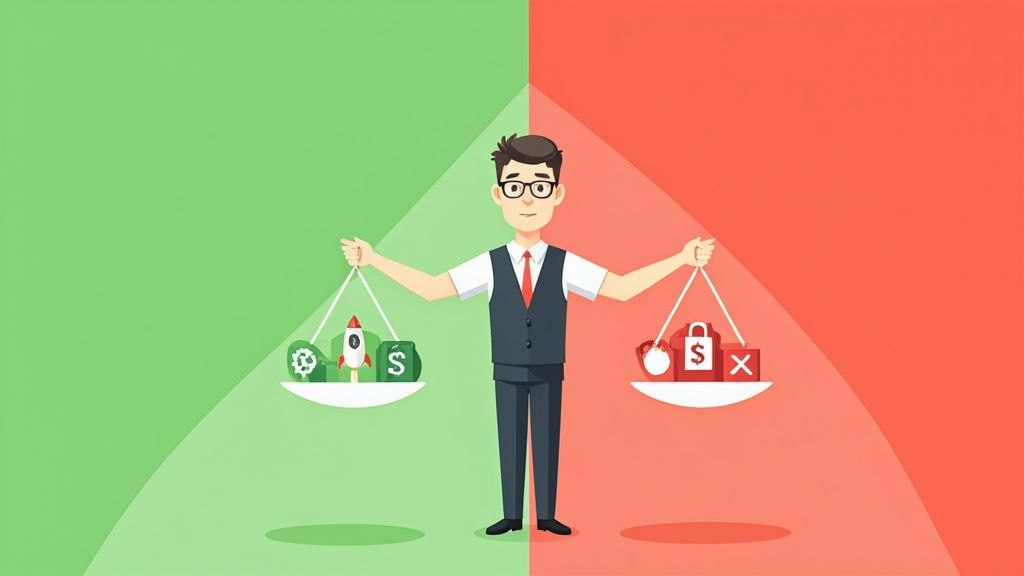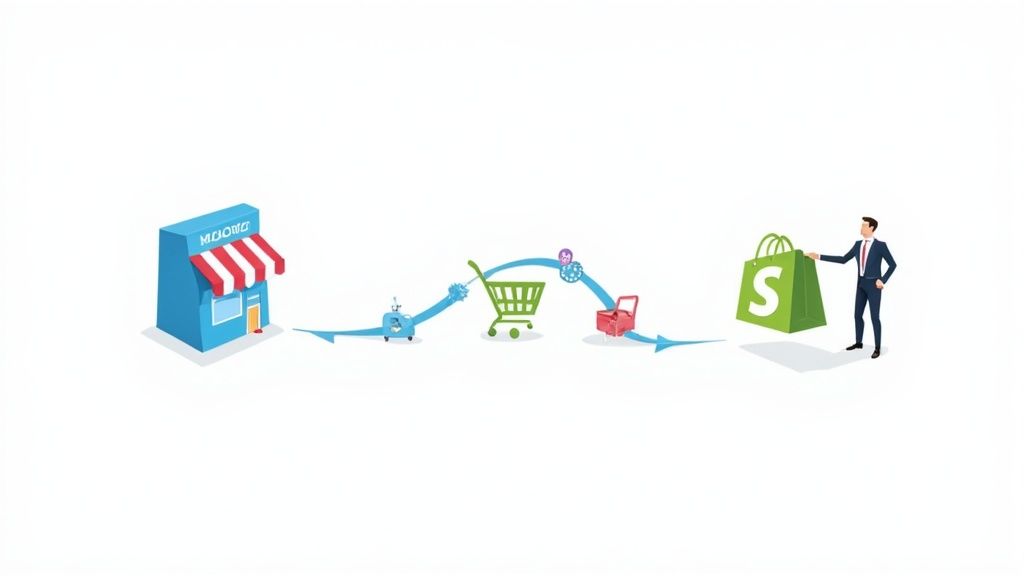
Think of the TikTok Shop policy as the official rulebook for your store. It’s the essential operating manual that keeps the entire marketplace safe, reliable, and consistent for the millions of people scrolling and shopping.
Understanding the TikTok Shop Policy Framework

Jumping into TikTok Shop is exciting, but real success is built on more than just viral content and trendy products. At its heart, the entire marketplace runs on trust. The TikTok Shop policy is the blueprint for building and protecting that trust between you and your customers.
It’s not just a long list of "don'ts." It’s a framework designed to help you build a credible, profitable, and long-lasting business on the platform.
Getting a handle on this framework means you can stop worrying about accidentally breaking a rule and start proactively creating a shop that TikTok’s algorithm and its users will love.
Core Principles of the Policy
The policies all boil down to a few fundamental goals. At the end of the day, these rules make sure that when a customer buys something, they get exactly what was advertised, it arrives on time, and it comes from a seller they can count on.
It really breaks down into a few key areas:
- Seller Conduct: This is all about being a good business owner. It covers professional and ethical behavior, like communicating honestly and maintaining a positive reputation. No funny business allowed.
- Product Authenticity: This is a big one. TikTok is serious about stopping counterfeit or pirated goods. Every single item you list must be genuine and represented accurately. It’s about protecting brands and protecting buyers from scams.
- Customer Service Excellence: From how fast you ship to how you handle returns, the policies set clear standards for the entire customer experience. The goal is to make sure buyers feel supported and confident from the moment they click "buy."
How Policy Compliance Affects Your Shop
Here’s the bottom line: following these rules is directly linked to your store’s visibility and success. TikTok keeps a close eye on things with its Seller Performance Evaluation system, which is basically a report card for your shop.
This system tracks metrics that are a direct result of how well you’re sticking to the policies.
For example, metrics like your Late Dispatch Rate and Seller-Fault Cancellation Rate are black-and-white indicators of how you’re doing with fulfillment. If those numbers start to slip, you can bet there will be consequences.
Ultimately, you don't need to memorize every single line of the policy document. What's more important is understanding why these rules exist. They’re here to create a vibrant, trustworthy marketplace where everyone wins. When you align your shop with these principles, you’re not just avoiding penalties—you’re building a sustainable brand that customers will keep coming back to.
Navigating Prohibited and Restricted Products
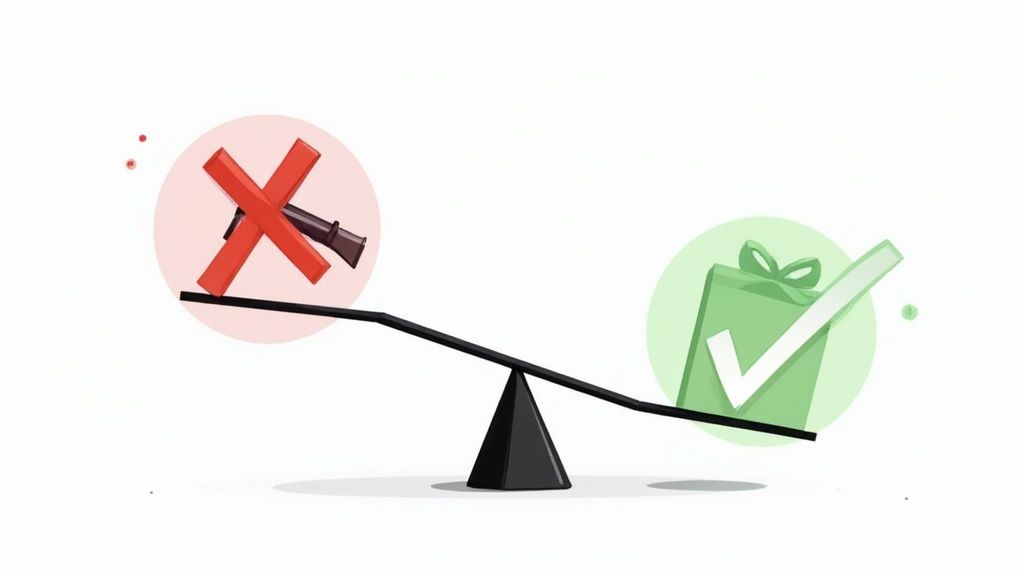
Listing a forbidden item is one of the fastest ways to get slapped with a violation on TikTok Shop. For sellers, the real challenge is that the lines between what's allowed and what's not can feel incredibly blurry, making it far too easy to make an honest mistake.
To stay compliant, you need to get crystal clear on the difference between products that are completely off-limits and those that just require a few extra hoops to jump through.
Think of it this way. Prohibited products are like running a red light—there’s no gray area, and the consequences are immediate and painful. These items are flat-out banned. On the other hand, restricted products are more like driving in a carpool lane; you can be there, but you need the right permit (or in this case, the right documentation and approval).
Getting this wrong can lead to delisted products, a pile of violation points, or even getting your entire shop suspended. The whole tiktok shop policy is designed to protect users and maintain trust, so they don’t take these rules lightly.
What's the Difference, Really?
Prohibited products are the non-negotiables. These are items TikTok has flagged as a direct risk to safety, legality, or the platform’s integrity. They will always get rejected, and listing them is a serious breach of the rules.
Common examples of prohibited products include things you'd probably expect:
- Weapons and Ammunition: Firearms, explosives, and all related gear.
- Illegal Drugs and Paraphernalia: Anything illegal or that promotes illegal drug use is a hard no.
- Hate Speech and Discriminatory Items: Products promoting violence, discrimination, or hate are banned.
- Counterfeit Products: Selling fakes is a huge violation and a quick way to get permanently banned.
Restricted products are the tricky ones. They aren't illegal, but due to their nature, they're under a microscope. To sell these, you have to apply for permission first and prove you meet all the necessary legal and safety standards.
For a quick cheat sheet, here’s a table that breaks down the core differences.
Prohibited vs Restricted Products Quick Reference
This table should help you quickly categorize your own products and figure out your next steps.
Diving Into Restricted Product Categories
For any item that falls into a restricted category, you need to get your ducks in a row before you even think about creating a listing. This proactive approach shows TikTok you’re a serious, legitimate seller with safe and authentic products.
Key Insight: The burden of proof is always on you, the seller. Have your documentation—safety certifications, licenses, or proof of authenticity—ready to go before you attempt to list.
Examples of restricted products that often require pre-approval are:
- Beauty and Personal Care: Certain cosmetics or supplements making specific health claims often need ingredient lists and safety certifications (like FDA registration).
- Refurbished Electronics: Selling used or refurbished tech typically requires proof of professional inspection and a crystal-clear warranty policy.
- Jewelry and Precious Metals: High-value items might need authentication certificates to verify their quality and origin.
And here’s a crucial point: these rules can change depending on where you're selling. A product that’s fine in one country might be restricted or even prohibited in another. Always double-check the specific guidelines in your Seller Center for every region you operate in.
How to Audit Your Inventory Like a Pro
The absolute best strategy is to audit your inventory before you create a single listing. It’s a simple check that can save you a world of hurt down the road and keep your account health in the green.
- Categorize Your Products: Start by grouping your inventory into logical categories like "skincare," "apparel," or "home electronics."
- Cross-Reference with TikTok's Rules: Open up the official TikTok Shop Prohibited and Restricted Products guidelines right from your Seller Center. Have it handy.
- Check Each Category: Go through your own product list, category by category, and compare it against TikTok's rules. If something falls into a restricted category, flag it immediately.
- Gather Your Paperwork: For every item you flagged, start collecting the required documentation now. This could be anything from supplier invoices and CE certifications to lab test results.
- Get Approval: For all restricted products, submit your documentation for approval through the Seller Center before you try to make the listing live.
If you treat the tiktok shop policy as a roadmap instead of a barrier, you can list your products with confidence, knowing you're set up for long-term success.
Once your products get the green light for being compliant with TikTok Shop policy, the next hurdle is presenting them correctly. It’s not just about what you’re selling, but how you sell it. Think of your listing as your shop's first impression—it needs to build trust and turn views into sales without tripping any of TikTok's alarms.
Every single piece of your listing, from the title right down to the background music in your video, gets a once-over from TikTok’s review system. The platform’s growth has been nothing short of explosive, with its global Gross Merchandise Value expected to rocket to $33.1 billion in early 2025. This kind of scale means they have to be incredibly strict to maintain a marketplace that millions of users can trust.
Crafting Flawless Product Titles and Descriptions
Your product title and description are your main sales pitch, but on TikTok, accuracy trumps everything. Any hint of misleading information is a surefire way to get a violation. Your title is the headline, and the description is the story—both need to grab attention, but they must be completely factual.
A classic mistake is making claims you can't back up. For example, you absolutely cannot claim a skincare product "cures acne" or a supplement "guarantees weight loss" unless you have the official certifications and approvals to prove it.
Here’s how to stay in the clear:
- Be Specific and Accurate: Ditch vague titles like "Best Phone Case." Instead, go for something like "Durable Shockproof Silicone Case for iPhone 15."
- Avoid Superlatives: Words like "best," "number one," or "miraculous" are instant red flags unless you have official documentation to back them up.
- Disclose All Details: Be upfront about the product's condition (new, refurbished), materials, size, and exactly what the customer gets in the box.
Mastering Visuals: Images and Videos
On a platform that lives and breathes aesthetics, high-quality, authentic visuals are everything. Blurry, low-res, or stolen images won't just kill your sales; they'll likely get your listing flagged. TikTok’s rules are simple: the product in your photos and videos must be the exact one the customer receives.
This extends to your videos' audio, too. A lot of sellers get caught using popular, copyrighted music without the right license, which can get their content taken down in a heartbeat.
Key Takeaway: Your product media has to be a true, clear representation of what you're selling. Steer clear of generic stock photos or any visuals that don't perfectly match the item's color, size, or features. This transparency is the bedrock of TikTok Shop policy.
Run through this quick checklist to make sure your visuals are up to snuff:
- Use High-Resolution Images: Make sure your photos are crisp and show the product from several different angles.
- Showcase Authenticity: Use photos of the actual product, not a 3D render or an image you grabbed from another website.
- Use Royalty-Free Audio: Play it safe and stick to TikTok’s Commercial Music Library for any sound in your videos.
The Unbreakable Rule: No Off-Platform Transactions
This is one of the biggest and most critical rules that new sellers stumble over: the policy against off-platform redirection. TikTok has a zero-tolerance stance on any attempt to lead customers to buy something outside of the TikTok Shop ecosystem. It completely undermines the platform's security and trust.
This means you can't:
- Put your website URL in a product description or video.
- Show a QR code that links to an external store.
- Verbally tell viewers to "DM for a link" or "visit my site to buy."
Any trick to divert traffic is seen as trying to game the system and can result in serious penalties, including getting your store shut down immediately. For sellers coming from other platforms, this can be a tough adjustment. Learning how to integrate your existing operations, like finding out how to properly connect your Shopify store with TikTok Shop, is the key to managing sales effectively while staying within the lines. On this point, compliance isn't just recommended; it's mandatory.
How to Maintain Excellent Account Health
Think of your TikTok Shop Account Health dashboard as your store's official report card. TikTok grades you on everything, and this isn't just for show. This score directly impacts your store’s visibility, the features you get to use, and ultimately, whether you can even keep selling. It's like a video game where a high score unlocks perks and a low score brings on the penalties.
Understanding how this works is critical to mastering the tiktok shop policy. Every move you make—from how fast you ship an order to how you handle a customer question—is tracked and measured. These actions all feed into your overall account health score, and a strong score signals to TikTok that you're a trustworthy seller, which can earn you a nice boost from the algorithm.
Decoding the Violation Points System
At the heart of account health is a penalty system based on points. When you break a rule, TikTok hands out violation points. These aren't permanent marks against you; they build up over time and serve as warnings that your performance is slipping.
The whole point of the system is to get you to correct your course, not just to punish you. A couple of points might just get you a warning, but if you let them pile up, the consequences get much more serious.
Key Insight: Violation points typically expire after 180 days. This creates a rolling window where you need to stay on top of your game. A single mistake won't sink your shop, but a consistent pattern of poor performance will lead to bigger and bigger penalties.
The punishments are tiered based on how many points you've accumulated. A few points might just mean a formal heads-up. But once a shop hits 24 points, they could be looking at a temporary suspension. If a seller gets all the way to the 48-point threshold, TikTok might shut down their shop for good.
Critical Metrics That Define Your Score
While lots of little things feed into your score, a few key metrics carry the most weight. If you focus your energy here, you'll get the best bang for your buck in keeping your account in good standing. This is where the rubber meets the road when it comes to the tiktok shop policy.
- Late Dispatch Rate (LDR): This is the percentage of orders you don't ship within your stated handling time. A high LDR screams "fulfillment issues" to TikTok, which means a bad experience for the customer.
- Seller-Fault Cancellation Rate: This tracks orders you cancel because of a mistake on your end, like selling something you don't actually have in stock. It’s a direct reflection of how well you manage your inventory.
- Negative Customer Reviews: Low star ratings and bad feedback are a huge red flag. They tell TikTok that your product quality might be poor or that your descriptions aren't accurate.
This infographic shows how every single piece of your listing plays a role in compliance, which is your first line of defense against bad reviews.
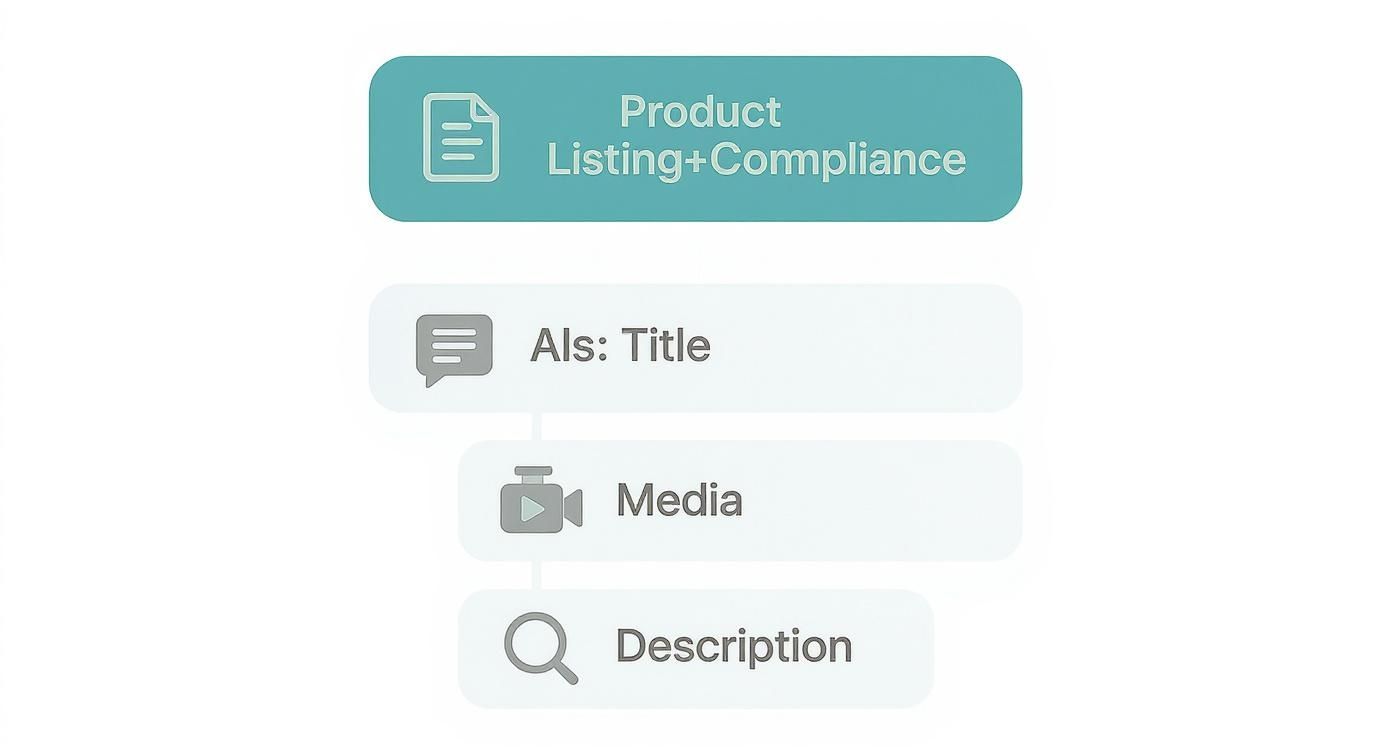
As you can see, it all starts with the listing. From the title and images down to the description, everything needs to be accurate to set the right expectations for your customers from the very beginning.
Actionable Strategies for a Healthy Account
Keeping your account in great shape isn't about being flawless—it's about having solid, repeatable processes to consistently meet TikTok's standards. Trust me, proactive management is a lot less stressful than scrambling to fix problems after they happen.
Here are a few practical steps to keep your metrics looking sharp:
- Dial in Your Shipping: Don't let orders pile up. Set a firm daily cutoff time for packing and use a shipping carrier you can rely on. If you know a delay is coming, get ahead of it and let your customer know immediately.
- Keep Your Inventory Count Spot On: Do regular stock checks to avoid selling products you don't have. If you sell on other platforms, an inventory management system that syncs your stock everywhere is a lifesaver. This is the single best way to keep your seller-fault cancellation rate low.
- Talk to Your Customers: Answer questions quickly and professionally. If someone leaves a negative review, respond to it publicly with a helpful, non-defensive solution. This helps that one customer and also shows potential buyers that you're a seller who cares.
- Make Returns Painless: Your return policy should be crystal clear and easy to find. When a return request comes in, handle it promptly according to the tiktok shop policy. A smooth return can actually turn an unhappy customer into a repeat buyer.
What to Do When You Get a Violation Notice
https://www.youtube.com/embed/NCaO0PsSpzg
Seeing that red flag in your Seller Center is a gut-punch moment for any seller. It feels like getting called to the principal's office, and it's easy to panic. But take a breath. A violation notice isn't the end of the world; it’s a signal that something needs your attention.
Think of it less as a punishment and more like a diagnostic report from TikTok. The platform has flagged a specific issue with one of your listings, and your job is to play detective. You need to calmly figure out what went wrong, gather the right proof, and make your case clearly and professionally.
How you handle this process is what separates the pros from the amateurs. Getting good at this means you can get your products relisted quickly, while others let points pile up and put their entire shop at risk.
First, Break Down the Violation Notice
Before you fire off an angry email or delete the listing in a panic, you have to understand exactly what the issue is. Your starting point is the notice itself in the Seller Center. Don't just skim it—read every single word.
The notice should tell you three critical things:
- The Exact Policy Breached: It won’t be vague. It will name the specific TikTok Shop policy you’ve supposedly broken, like "Misleading Product Information" or "Prohibited Product."
- Which Product Is the Culprit: The notice will point to the exact listing (or listings) that triggered the violation.
- The Date of the Violation: This is useful for keeping your records straight.
This information is your road map. If you don't know the specific charge, you can't build a defense that makes sense. A generic appeal is a wasted effort and will almost certainly be denied.
Gather Your Evidence and Build a Strong Case
Once you know the what and why behind the violation, it's time to build your case. This isn't about writing a heartfelt apology. It's about providing cold, hard, factual evidence that either proves the violation was a mistake or demonstrates you've already fixed the problem.
Your evidence has to directly address the specific reason for the violation.
Pro Tip: Your appeal needs to be built on proof, not just promises. TikTok's review teams see thousands of cases a day. They respond to clear, verifiable documents that directly counter the violation claim, not emotional pleas.
Here are a few real-world examples:
- Got a "Counterfeit Product" claim? Dig up your supplier invoices, letters of authorization from the brand owner, or any authenticity certificates you have.
- Flagged for a "Misleading Description"? Take screenshots of your listing and compare them side-by-side with photos of the actual product to prove they match up.
- Hit with a "Shipping Violation"? Pull up your shipping receipts, carrier tracking numbers, and proof of on-time dispatch to show you did your part.
It's also worth understanding the true cost of compliance violations beyond the immediate notice. The financial hit can be significant, which is why getting these issues sorted out quickly is so important.
Write a Professional and Effective Appeal
With your evidence organized, you’re ready to write the appeal. Keep it professional, to the point, and respectful. Stick to the facts and leave emotion out of it.
Structure your appeal logically so it's easy for the reviewer to follow:
- State the Violation: Start by clearly identifying the violation notice you're appealing.
- Explain Your Position: Calmly and concisely explain why you believe the violation is incorrect or has been fixed. This is where you reference your evidence. For example: "As shown in the attached invoice (Exhibit A), this product was sourced directly from an authorized distributor."
- Attach Your Evidence: Label and attach all of your supporting documents clearly.
- Outline Corrective Actions: If you were in the wrong, own it. Briefly explain the steps you've taken to make sure this doesn't happen again.
Submit your appeal through the Seller Center, and then try to be patient. Review times can vary, but a well-documented and professionally written appeal gives you the absolute best shot at getting those violation points removed and your products back online.
Proactive Strategies for Long-Term Compliance

Surviving on TikTok Shop shouldn't feel like you’re constantly walking on eggshells. The truly successful sellers aren’t just putting out fires—they’ve built systems to stop those fires from ever starting. The real secret is shifting your entire mindset from being reactive to proactive. That’s how you build a resilient, long-lasting brand on the platform.
And this isn't just about dodging violation points. It's about building a business that the TikTok algorithm actually wants to promote. When your store has excellent metrics and a clean record, it signals quality to both customers and the platform. The reward? More visibility and, ultimately, more sales. Think of compliance less as a chore and more as a direct investment in your shop's growth.
Build a Routine of Regular Self-Audits
The best way to stay out of trouble is to find potential problems before TikTok does. Just like you'd get your car a regular oil change, your shop needs a quick check-up. Setting aside time for a monthly self-audit is a simple but incredibly powerful habit. It keeps your listings and operations perfectly aligned with the latest TikTok Shop policy.
A great starting point is implementing a compliance audit checklist to make sure you don't miss anything. Your monthly check-in should cover these core areas:
- Listing Review: Take a quick scan of your top-selling product listings. Are the titles, images, and descriptions still 100% accurate?
- Inventory Check: Double-check that your stock levels are correct. This simple step helps prevent overselling, which is a major cause of seller-fault cancellations.
- Performance Metrics: Spend just five minutes in your Account Health dashboard. See any numbers trending in the wrong direction? Now is the time to fix them.
This simple routine turns compliance from a dreaded, unexpected crisis into a predictable, manageable habit.
Stay Informed and Maintain Meticulous Records
TikTok's rules aren't set in stone; they change and evolve as the platform expands. As a seller, the responsibility to stay updated falls squarely on your shoulders. Get in the habit of checking for announcements in your Seller Center or the Seller University portal at least once a week.
Takeaway: Pleading ignorance about a new rule won't get you very far in an appeal. Staying on top of policy updates gives you the power to adapt quickly, keeping your shop safe from easily preventable violations.
Beyond staying informed, organized documentation is your absolute best friend. If a violation notice does land in your inbox, having your paperwork ready can mean the difference between a quick fix and a lengthy, painful suspension.
Keep digital folders for everything:
- Supplier Invoices and Letters of Authorization: These are non-negotiable for proving product authenticity.
- Product Certifications: If you sell items in restricted categories, have your safety reports or FDA documentation ready to go.
- Shipping and Fulfillment Records: Proof of on-time dispatch is your key defense against fulfillment-related dings.
For brands looking to scale without the compliance headaches, partnering with a specialized TikTok Shop agency can be a game-changer. They provide the expert oversight needed to keep everything running smoothly. At the end of the day, proactive management is about building a rock-solid foundation of trust—one that pays off with loyal customers and favor from the algorithm.
Got Questions About TikTok Shop Policies? We’ve Got Answers.
Running a store on any platform means you're bound to have questions about the rules. It's totally normal. Let's clear up some of the most common things sellers ask about TikTok Shop's policies so you can get back to business with confidence.
What Happens If I Get a Violation?
Okay, so you got a violation notice. Don't panic. When you break a rule, TikTok adds violation points to your account. Think of them as demerits. A few points might just get you a formal warning, but if you start racking them up—say, you hit 24 points—you could be looking at a temporary suspension of your store.
Each notice you get will spell out exactly which policy you tripped over, so you’re not left guessing.
How Long Do These Violation Points Stick Around?
The good news is that violation points aren't a life sentence for your store. They’re designed to be a wake-up call, and they typically expire after 180 days.
It’s a rolling window, which means you always need to stay on top of your game. A steady stream of new violations can get you into hot water, even if your older points are falling off the record.
The Bottom Line: That 180-day expiration is your chance to clean up your act. But it also means consistent, good behavior is non-negotiable if you want to avoid hitting those serious penalty levels.
Can I Fight a Violation Notice?
Absolutely. If you get a notice and think, "Wait a minute, that's not right," you can—and should—appeal it. You'll do this through your Seller Center, but you need to come prepared. A successful appeal is all about the evidence.
You’ll need to provide clear, factual proof that directly counters their claim. For example:
- Got a counterfeit claim? Show them your supplier invoices.
- Accused of shipping late? Pull up those shipping receipts.
- Customer says the product isn't as described? Send photos or videos that prove it is.
The more professional and well-documented your appeal is, the better your shot at getting those points wiped from your record.
Ready to grow your eCommerce brand without the compliance headaches? The experts at ECORN specialize in scaling Shopify stores with proven design, development, and CRO strategies. Learn more at https://www.ecorn.agency/.














